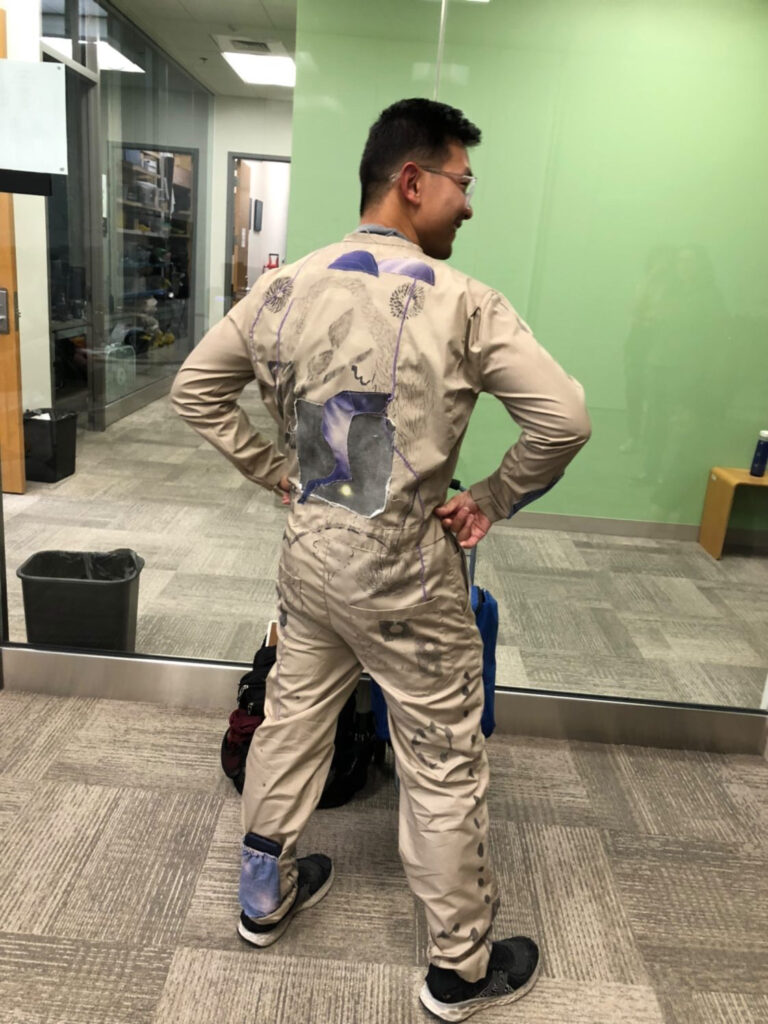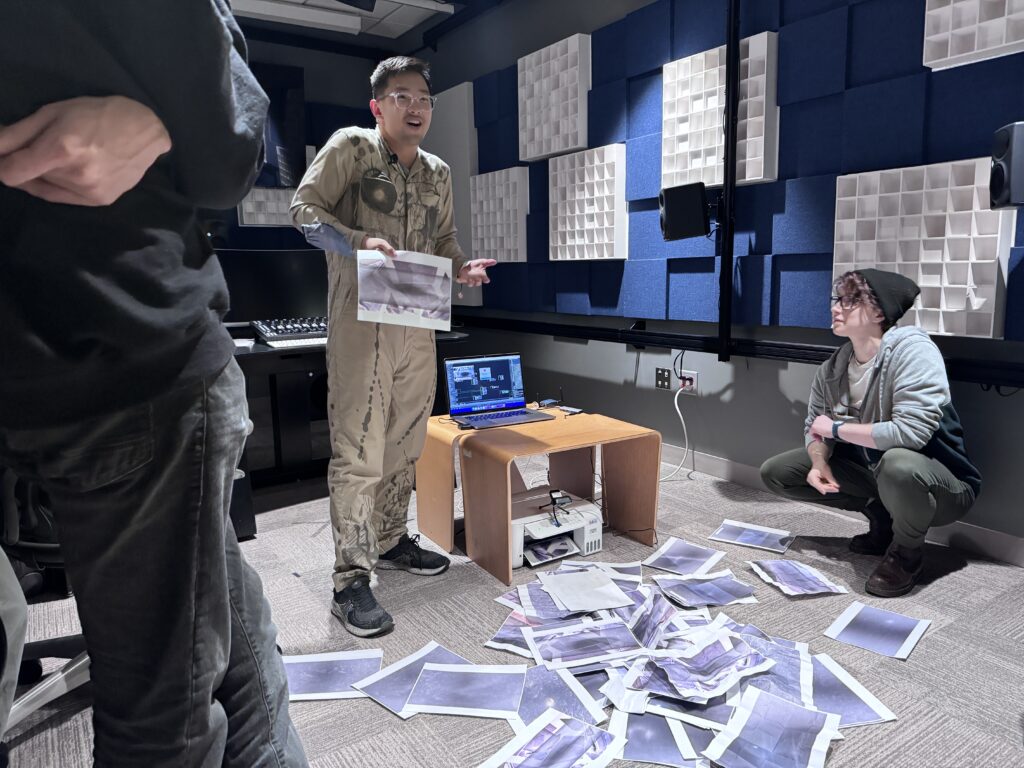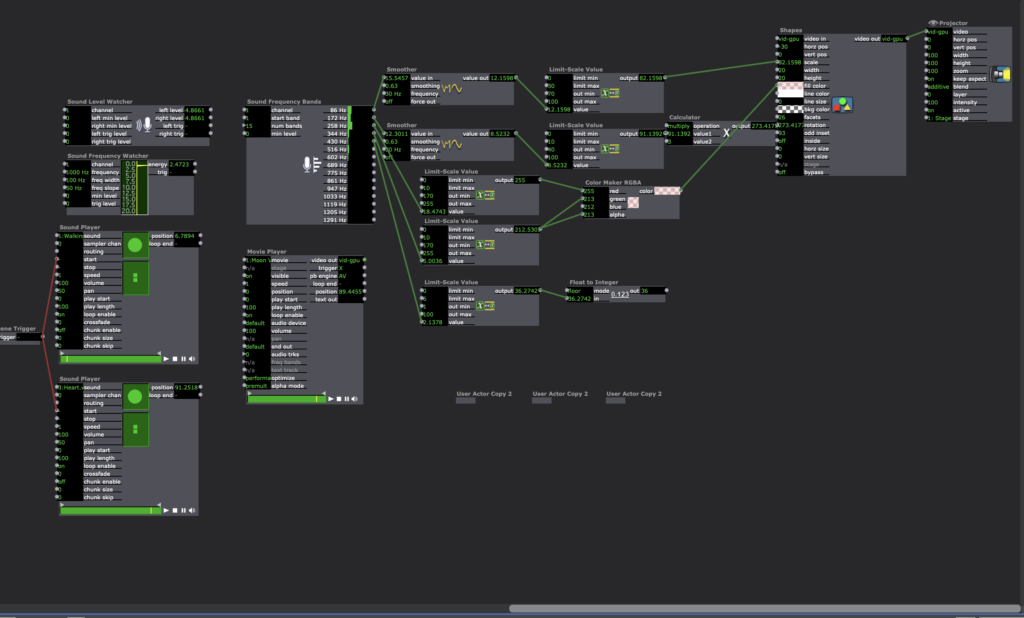Body as Reservoir of Secrets, DEMS Cycle 3
Posted: December 12, 2023 Filed under: Uncategorized Leave a comment »In cycle 3, the three things I focused on were:
- Refined the composition of the graphics generated. Included more gaussian blur effects to reduce the number of hard-edges present in the work. The reduction of hard edges was intentional to reduce the “digital” nature of the graphics.
- I continued to develop the costume. I drew, painted and stitched in the costume, to create a more shamanistic leaning for the costume, hoping to steer away from an immediate aviation or space travel reference.
- I managed to program a Hot Folder in my computer, so that syncs up with the stage to image actor on isadora, and whatever Isadora exports to the Capture folder is automatically printed.


Decisions made:
- I decided to include an additional web-cam to do a live-capture of the pile of printed matter that was generated. The pile would then appear in some print outs.
- I moved the pulse sensing contact mic to my wrist due to the headache I experienced after the cycle 2 presentation.
- The score of the piece was supposed to be live-painting/collaging. There was not enough space/time for that to happen at ACCAD and the dec 8th critique. So I devised a score that was about folding each sheet of paper 8 times, and being unable to fold it the 9th time as a parallel to the irretrievable nature of ancestry.

Challenges/Feedback:
- My patch got very complicated and towards the end I was having some difficulty figuring how everything was wired, even though I did make an effort to be organized.
- Isadora crashed from time to time. I will look into buying a high capacity windows laptop next year.
- I needed some troubleshooting with the Hot Folder and took awhile to figure out why I was generating so many prints. Turned out that I had an earlier version isadora file running in the background which was feeding the hot folder a bunch of images.
- The prints generated had a general purple hue to them. It seems like I needed to vary the colors more in the graphics generated, so that this purple hue is counteracted/balanced.
Observations/ Ongoing curiosities:
- The printer working generated an unexpected mechanical soundscape to the piece. The rhythmic and hasty machine sound creates a sense of urgent-ness to the work, I find myself feeling some anxiousness and felt pressure to work at that rhythm/pace. I felt “chased” by the printer.
- A classmate posed me a question about generative art, and how generative art tend not to have any material cost to it. She asked me how I felt about the paper and ink expended for this performance. I actually welcome the creation of these materials because as an artist working in collage, I hardly throw away anything because I save everything in flat files. These materials will eventually find its way into another piece of work in the future.
- I intend to stage a cycle 4 in the Sherman Studio Arts Center after the semester quietens down. Cycle 4 will have the live-painting aspect and I will be exploring using what I have created in this class, as means to create a video work. I am also curious about how feature extraction can influence sound and be used for composing.
Body as Reservoir of Secrets, DEMS Cycle 2
Posted: December 12, 2023 Filed under: Uncategorized Leave a comment »For cycle 2, the idea started to take shape in a more concrete manner. I started to develop the costume using coveralls bought on amazon which I tailored myself for a better fit.
The following feature extraction functionalities were in the costume-
- On the coveralls I stitched on some patches with dark pieces of digitally printed fabric. This increases the overall contrast of the figure, which helps the eyes++ actor and webcam track object movements better.
- A contact microphone was housed in the chest pocket running up to my neck. An additional elastic band was devised to apply pressure and hold the contact microphone in place.
- Two iphone Gyroscopes were housed within blue/purple pockets with elastic openings on the arm and calf of the custom.
- A microphone was blown into whenever a scene change was desired, as a means of activating breath.
Challenges/Feedback
- Composition looked too busy given that more than 10 variables were being fed into isadora.
- My computer’s graphics card seems to be struggling and isadora crashes easily.
- A classmate mentioned that the costume appeared like an astronaut, which is not what I intended.
- I had a headache after wearing the neck piece with the contact mic for 20 minutes because it was restricting bloodflow.
Observations/On-going curiosities
- The class seems to be very interested to map/figure out which visual element was coupled with the various sensors.
- The class seems to be interested view the live generated graphics as a video piece, when I had intended the graphics primarily to be viewed as prints. I am open to the possibility of the video being screened alongside the painting performance.
Body as Reservoir of Secrets, DEMS Cycle 1
Posted: October 31, 2023 Filed under: Uncategorized Leave a comment »I see the body as a reservoir of ancestral secrets. I have been coaxing out /imaging these secrets as an abstract painter, through gestures and paint. However, gesture is only one vector in this exploration. The body generates streams of data in addition to gesture that can be harnessed and imaged- such as breath, heartbeat, voice.
I am devising a system that extracts these features and maps them accordingly to the movement/color/scale of visual elements, triggering video or image files. These visual elements come together in compositions that will then have video and print outputs, via the capture stage to image and video actors.
In Cycle 1, I mostly concentrated on figuring out isadora-OSC/gyroscope communications and tuning hardware like webcams and lavalier microphones for feature extraction. The outcome was somewhat successful, but I have generated too many input data streams and are lacking variables to plug these inputs. Feature extraction for hearbeat is not very effective using a lavalier microphone.
For Cycle 2, I intend to:
- Focus on creating more variables to plug the generated inputs into.
- Develop greater flexibility in the visuals generated, so that there is more variance in the composition- composition can range from very simple and very complex.
- Include a contact microphone for heartbeat extraction
- Start to integrate costume into mix.
For Cycle 3, I intend to:
- Develop a clarified live performance dimension to the work
- Figure out how to feed the captured jpegs to a printer
Pressure Project 1
Posted: October 17, 2023 Filed under: Uncategorized Leave a comment »In this pressure project, I was very much so tinkering with the software, trying to figure on what to plug where.
In Scene One, I was also experimenting with the various sliders the shape actor, combining them with the envelop, wave and pulse generators to create what I deem an interesting animation. I also did some tuning of frequency, amplitude and phase of curves for various generators so as to create an orbital effect in the moving agents. I was mindful to include user actors, to create independent objects on the stage. These user actors make sense for me from the perspective of object oriented programming.
In Scene two, I imported a video I made and experimented with the kaleidoscope actor.
Overall, I was not totally satisfied with this project and what it achieved, but I am ok to treat it more like a “study” piece.
Here’s my patch for sharing:
https://drive.google.com/file/d/1NSRfCIi78JRKkM_2lV559OdPd70sWCkj/view?usp=sharing
Pressure Project 2
Posted: October 17, 2023 Filed under: Uncategorized Leave a comment »In this project, I was inspired by Charles Csuri’s line work that appears in his work swan lake piece and his humming bird piece.
I experimented with various actors to manipulate the webcam image, such as difference, gaussian blur, shimmer, in order to impact how the eyes ++ actor was responding to the live capture. I wanted more simultaneous capturing of multiple moving objects, and i found the reflector actor to serve my intended purpose well. The numbers generated by the eyes ++ actors were fed into scale, position etc of the moving elements.
As for the moving visual elements, I created simple line drawings using photoshop, and exported them as PNGs with transparent backrgounds. I managed to device a way to call various images into the background using the numbers from the eyes ++ actor. See screenshot below. I will be using this more.

In the work, I also experimented with the 3D Particle generator, but it was not very successful. There were just too many sliders to account for, and after tinkering with it for 2-3 hours, it feels like I only have a sense of what 20% of them do. I also managed to work in the get stage image actor and capture stage to image actor, which I will be experimenting more for cycle 1 of my project.
Here’s my patch to share if you are interested.
https://drive.google.com/file/d/18Tq5N5q7md8nW2IadXUaUh_7EnQI9PIo/view?usp=sharing
IZZ feeding sound practice
Posted: September 26, 2023 Filed under: Uncategorized Leave a comment »
In this practice, I fed into isadora sound files of my own humming, the sound of my heart beat and footsteps. The raw numbers from the sound frequency actors were manipulated through the limit scale, calculator and smoother actors, before being plugged into the shapes actor, changing up the location, scale, rotation and color of the objects. I also used duplicated user actors to create multiples of the same moving object.